(Update March 18, 2012: Second chapter is now on line
HERE.)
(Benson fans may appreciate a walk-through of Benson's central business district,
HERE.
(Yet another update, March 30. A vintage Club 64 menu has surfaced! Read All About It
HERE.)
(Another update, Friday, March 19.
HERE.)
(Update: I posted a follow-up to this article on Friday, March 12, 2010, responding to some of the recent and not so recent comments received here. You can read this follow-up
HERE)
When you think of Omaha cuisine, what comes to mind?
The Reuben sandwich, perhaps? Two Omaha institutions (or more) claimed to have invented it, neither of which survive to back up their claims.
The TV Dinner, maybe? Uh-huh, TV Dinners were invented here! (Hmmmm ... you really don't hear the expression "TV Dinner" anymore, do you?)
The Runza? Well, sortakinda -- uh -- no, not really, actually.
The Tavern sandwich? Nope, that's Iowa.
Unlike other major cities, Omaha doesn't really have its type of pizza, borrowing from many others (okay, okay, maybe Godfathers, but that's really a brand, not a style!), nor its type of barbecue, borrowing from Kansas City, Memphis and others.
The one thing you do think of when you think of food in Omaha is steak! Omaha is in The Beef State, and has a long history with the meatpacking industry.
What I first remember as what I would call "Omaha Cuisine" was that which was featured by countless independent Omaha steak houses, most of them operated by multi-generation Italian families.
These were not unlike the Sicilian red-sauce places back east, but featured more steaks, chops, and seafood to an extent, as well as the traditional Italian specialties.
The typical entree came with sides included, unlike the Morton-Chris ilk of today, with a house salad in a garlic-rubbed wooden bowl, and, of course, a side of pasta. :) A carafe of house wine was optional. :)
Let's take a few minutes and reflect of the cuisine long departed ...
I'm also doing something I never intended to do. I'm using some photos other than my own, collected from various sources, as well as various ads, to illustrate what is long gone.
Cantoni's:
The first restaurant of this type I remember very well was Cantoni's, which stood for years at the corner of 19th. and Leavenworth. I became acquainted with the hostess, who recommended it to me, and I visited semi-regularly until its demise.
This was a true family-operated restaurant, operated at first by Lou Cantoni and family, and later by the Marchello brothers.

What happened?
Nobody seems to know. It just closed one day at short notice, sometime around 1977. It reopened briefly as a Mexican restaurant, closed again, then opened again briefly with their former Italian-steakhouse theme, and then closed for good. The Marchello brothers remained in the catering business into the 1980s.
What's there now?
It's a bar. Connections. The Marine Room, their party and overflow room, is now a tattoo parlor.
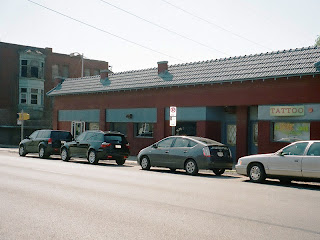
The building, however, is better known for a latecomer to the restaurant scene, Dixie Quicks, which occupies the westmost portion of the building, a portion not occupied by Cantoni's. Dixie Quicks was featured on the Food Network's
Diners, Drive-ins, and Dives program.
Sparetime:
The Sparetime Cafe, operated by the Nisi family, has a long history in Omaha.
The Sparetime I remember was the one at 5th. and Pierce, right in the heart of Omaha's Little Italy. As I researched things, I found far more references to a Sparetime "On the Strip" on south 72nd.

I distinctly remember the Sparetime at the original location in the late 1970s, but those in the know tell me that they moved to 72nd., and a Mexican restaurant opened at the old location, until, yes, the Sparetime moved back!
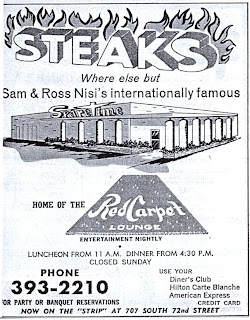
The section of south 72nd. between Dodge and Pacific streets was known in the 1960s and 1970s as "The Strip", no, not for casinos, but for clubs and restaurants.
I really don't remember the Sparetime on the Strip, but the evidence tells me otherwise. :)
What happened?
As I said, I don't remember the Sparetime on the Strip. I best remember the Sparetime when it moved back to Little Italy to the original location.
In the mid 1980s, the Nisi family sold the original Sparetime building on 5th. to the operator of Bob's Country Fixins, which operated out of a much smaller location just south of the Burlington Station. Bob's moved to the old Sparetime building, only to be closed shortly after due to a tragic structural failure of the building!
Bob's never reopened.
What's there now?
There's not much left of the Strip on 72nd! I really can't think of any full-service restaurants on 72nd. between Dodge and Pacific.
Driving to the former Strip address, we see yet another cell phone office.

However, driving to the back brought back some memories. We see this building, shown below, now occupied by a social service agency. This was one of those "ah-ha" (Take On Me?) moments. :)
I remember dining at two restaurants in this building. First, a buffet kind of place, don't remember the name, but I was very underwhelmed.
Second, a Mexican place, again, underwhelming.
Both of these had to be in the late 1970s.
I believe that it was this building that housed the Sparetime on the Strip, with the cell phone shop being in what was the parking lot.

While the building on the Strip is recognizable, the site on south 5th. looks like a disaster area! It is!

This is all that remains of what was one of the most popular restaurants in the Omaha area.
The Gas Lamp:
Another family with strong ties to the Omaha restaurant and club scene is the Firmature family, and for years their flagship eatery was the Gas Lamp, at 30th. and Leavenworth.

What happened?
Fire!
Firmature's Sidewalk Cafe in the Regency complex served "Gas Lamp Prime Rib" into the 1990s, but that location finally succumbed during a Regency remodeling.
What's there now?
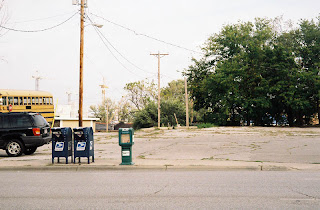
Nothing much! A parking lot. If you look carefully, you may see the remains of part of the foundation of what was the Gas Lamp.
Caniglia's:
There can be no discussion of family-operated restaurants in Omaha without mentioning the Caniglia family.
Although everyone pronounces this "can IG lee uh", those in the know tell me that it's properly pronounced "can EEL ia", with three syllables.
The Caniglia family is credited for popularizing pizza in the Omaha area, opening their long-lived flagship pizzaria and restaurant on south 7th. shortly after World War II.

The original restaurant was expanded several times throughout its lifetime.

What happened?
They blame the casinos.
What's there now?
Townhomes, on Caniglia Plaza.

Palazzo 'Taliano:
As the Caniglia family grew, so did its imperium, with several spinoffs, one which survives today.
One of the Caniglia's first aggressive expansions was the Palazzo 'Taliano, on south 84th., which some tell me was originally intended to replace the '40s vintage building in Little Italy.

What happened?
I don't know. They appear to have shifted their emphasis back to the original Little Italy location, which lasted until the mid 2000s.
What's there now?

It's a Shriners hall. Same building, still in great shape.
They tell me, however, that it had a brief second life as a dinner theater in the early 1970s.
Mr. C's:
One of the Caniglia brothers, Yano "Mr. C.", took off in a different direction in a different part of town. He opened the Royal Boy Drive-In, directly across from Fort Omaha, then a thriving Naval Reserve training center in North Omaha.

The drive-in was an immediate hit and became a popular hangout for North Omaha teens and sailors from the Navy base.
The drive-in expanded, added an indoor sit-down restaurant, and began to specialize in pizza and other Italian specialties, as opposed to burgers, chicken, and fries.

By the early 1970s, the drive-in was gone, and Mr. C's assumed the identity of a full-service restaurant.
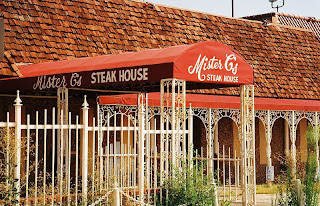
The interior decor, although somewhat meretricious, was classy in its own sort of way, with dayglow dioramas and such. "We put up the lights for the holidays and never took them down!"

Outdoor dining was featured in Mr. C's heyday, quite the contrast to the original outdoor dining in cars!

What happened?
They blame the casinos.
Now now, in all fairness, one prevailing reason for the closure was that Mr. C. wanted to retire and none of the close family wanted to take over the business.
What's there now?
The Mr. C. complex is still there, but abandoned, occupying the better part of a city block.

The facility is very large, in disrepair, in an area that is regarded as somewhat unsalubrious.


Other Caniglia's ventures included the Drawing Room, their Millard location, and the Top Of The world, in the Woodmen Tower, on the tippy-top floor (and charge it, please).
Little Frank's:
Caniglia's neighbor to the north, on south 7th., was Little Franks. What I remember most about this was that it was very brightly lit, more so than Caniglia's, with caricatures of the proprietors on the marquee.

What happened?
I don't think they can blame the casinos.
What's there now?
More townhomes.

Trentino's / Angie's / Lucky's:
Three incarnations, all a bit different.
I first remember this as Trentino's, a very nice Little Italy club and restaurant, and I considered this to be a cut above Caniglia's, Little Frank's, and Sparetime.

With very little warning it morphed into Angie's, named after Angelina Bonofede, whose recipes were used.
One semi-interesting trivium is that Trentino's used a 10th. Street address while Angies and Lucky's used the 1001 Pacific address.


Angie's was gone in a flash, soon to be replaced by Lucky's 1001, which never really caught on. Notice the signage.

What happened?
They blame the casinos, I think. (Blame Canada?)
What's there now?
Pssssst! Hey kid, wanna buy a restaurant?
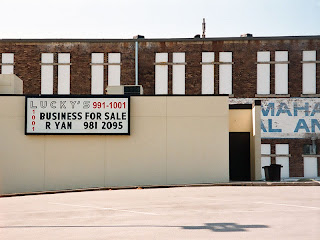
Ross':
The crown jewel of the 72nd. Street Strip was unquestionably Ross', operated for decades by the Lorello family. This has to be my all-time favorite Omaha steak house, and my first choice for introducing out of town guests to Omaha cuisine.
Ross' was a very classy place, and I am hard pressed to recall hearing even a single complaint about the place!


What happened?
Lack of progeny.
What's there now?

Hey, couldn't it have at least been a Ross's Dress For Less? :)
Marchio's:
Another one of my all-time faves was Marchio's in South Omaha. This is another place where I would always take out-of-towners to show them what Omaha dining was like.

What happened?
Don't blame the casinos, but you can blame the IRS!
What's there now?
Howard's, relocated from their 24th. St. location shortly after Marchio's closure.

Frankie And Phyl's:
This really wasn't a steakhouse, it was more of a "joint", something you might see on
Diners, Drive-Inns, and Dives on the Food Network, were it open today.
I might go as far as to call this one a genuine "dive", but in a positive sort of way. It was nothing to look at, outside or inside.
The food was great! The atmosphere was, well ..., gritty! A hardcore inner-city eatery.
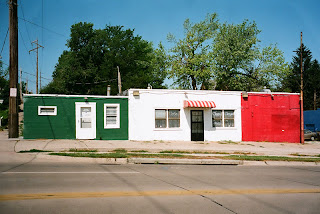
What happened?
I don't know. One day I drove by and it was closed.
What's there now?
The building is there, still standing, vacant. Salatamu!
Honorable mention!
I ran across this while perusing old ads.
Whoever needs the Big Mac and the Whopper, when you have the Miss Monster! :)

Uh, what happened to the eighth, and the ninth?
There are others, there are many others, remembered and forgotten, and to try to name them is an exercise in futility. These are the ones I remember, and the ones for which I can attest to excellence.
So, are the casinos really to blame?
Whenever a restaurant in the Omaha area closes, it seems like the reason the owners give is competition -- both in terms of dining choices and competition for disposable dollars -- from the casinos. Does this pass the sanity check?
We now have three casinos in the metro area. All three have a buffet, a steak house, and some kind of a casual diner or coffee shop. That's nine eateries added to the market among the three casinos.
If we look on the streets, on line, or in the phone book, we'll see countless other restaurants which have opened during the lifetime of the casinos. These include more contemporary steak houses, such as Sullivans, Paxton Chop House, Spencers, etc., and Italian places such as Vincenzo's, Malara's, and a whole slew of more casual pizza-pasta type places.
Add to that the recent openings of numerous Mexican and Asian offerings of ever-increasing popularity. We're not even counting the various cookie-cutter formula restaurants which spring up (and die) like weeds along our thoroughfares.
The nine offerings at the three casinos are easily eclipsed by the copious assortment of others which have opened in the area.
The real answer, however, is the opening of several new non-gaming restaurants in the immediate vicinity of the casinos, such as Ruby Tuesday, Quaker Steak and Lube, and yes, Hooters. All of these are packed on Friday and Saturday evenings, only footsteps from the nine casino-based choices.
So, are casinos to blame? I don't know, you decide!
Alive!
Survive!
Thrive!
Not all is lost, however!
In an era dominated by formula eateries, prefabricated Americana, and predictable mediocrity, Omaha still boasts several of the original, mostly Italian, steak houses, living on and doing what they know how to do best, serving Omaha's cuisine to this generation and the next.
Let's take a look at those you can enjoy today, none of which appear to be on the endangered species list!
Johnny's:
Johnny's Cafe has been an anchor of South Omaha, right on the edge of the former Union Stockyards. Johnny's was recently featured in the film
About Schmidt.


Johnny's has a loyal regular following, although I do think it's slipped a bit since I first sampled their fare back in the 1970s. Johnny's is still operated by the Kawa family.
Johnny's had a short-lived second location in Millard.
The place known as Johnny's Italian Steak House in Village Point(e), which is a chain, has no connection to the original Johnny's in South Omaha.

Gorats:
The best preserved of the bunch, virtually unchanged from the 1940s, has to be Gorat's, a favorite of mine and a favorite of gazillionaire Warren Buffett.

Compare the porte cochere and the signage in the pre-Mastercard era ad above to the 2008 photo below, unchanged, yet timeless!


Eat your heart out, Arnie Morton!
Piccolo's:
Another well-preserved specimen is Piccolo's, a.k.a. Piccolo Pete's.
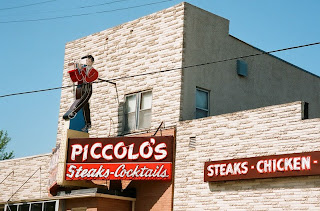
Cascio's:
The low-rise building, dating from the 1940s, has been spiffed up a bit in recent years, but the tradition lives on inside.

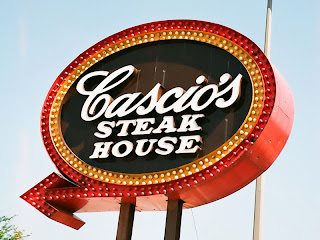
La Casa:
For those who don't know La Casa, take a look at the photo of their iconic sign. Don't look at the next photo, and tell me if this is a Mexican restaurant or an Italian restaurant. Which is it? :)

"La Casa" does translate to "the house" in both Italian and Spanish. I've known a few other restaurants in other locations known as La Casa, and all of them were Mexican. (I also remember an Italian restaurant known as The House in the Allston area of Boston.) :)
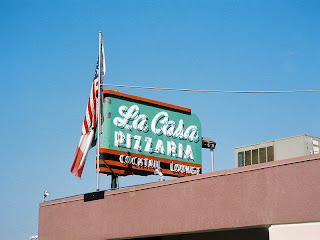
Anthony's:
On south 72nd. Street, but several miles away from what was the "Strip", Anthony's has stood for decades in what is otherwise a warehouse and industrial area.

Several of the restaurants used to have a similar steer statue. Ross' had theirs in an almost identical display a couple miles to the north.

Anthony's is trying to keep up with the times, with their Ozone ultra-lounge.


The sign notes the entertainment which is featured on Monday's.[sic]
Venice Inn:
Caniglia's lives on! The sole survivor of the once-mighty empire still stands proudly on Pacific Street.



























































































